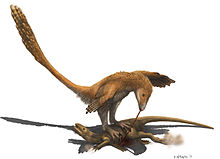| Zephyrosaurus Temporal range: Early Cretaceous, ~113 Ma PreꞒ Ꞓ O S D C P T J K Pg N ↓ | |
|---|---|

| |
| Mounted skeleton, Natural History Museum of Berlin | |
| Scientific classification | |
| Domain: | Eukaryota |
| Kingdom: | Animalia |
| Phylum: | Chordata |
| Clade: | Dinosauria |
| Clade: | †Ornithischia |
| Clade: | †Neornithischia |
| Family: | †Thescelosauridae |
| Subfamily: | †Orodrominae |
| Genus: | †Zephyrosaurus Sues, 1980 |
| Type species | |
| †Zephyrosaurus schaffi Sues, 1980 | |
Zephyrosaurus (meaning "westward wind lizard") is a genus of orodromine ornithischian dinosaur. It is based on a partial skull and postcranial fragments discovered in the Aptian-Albian-age Lower Cretaceous Cloverly Formation of Carbon County, Montana, USA. New remains are under description, and tracks from Maryland and Virginia, also in the US, have been attributed to animals similar to Zephyrosaurus. It lived approximately 113 mya.
Discovery and history

Hans-Dieter Sues named his new genus in recognition of the fossil being found in western North America, and Charles R. Schaff, who found the specimen. MCZ 4392, the type specimen, is composed of jaw fragments, the braincase and associated bones, several partial vertebrae, and rib fragments. He found the new genus to represent a previously unknown lineage of hypsilophodont (a taxon now considered not natural), similar in some respects to Hypsilophodon.
Because of the fragmentary nature of the type, and lack of additional remains, Zephyrosaurus had not attracted much attention until recently, when two separate events brought it more recognition. First, Martha Kutter, in a 2003 abstract, reported on new remains of this genus under study at the Sam Noble Oklahoma Museum of Natural History, including the remains of at least seven individuals with bones from all regions of the body.
Then, Stanford et al. (2004) published on dinosaur tracks from the Patuxent Formation of Maryland and Virginia, which they named Hypsiloichnus marylandicus and attributed to an animal akin to Zephyrosaurus based on the proportions of the hands and feet.
Description

Zephyrosaurus is still very incompletely known. Among other distinctive characteristics, it had a steep face, a raised knob on the upper jaw, and a larger knob on the cheekbone. Some of the bones may have allowed movement within the skull (cranial kinesis) as well. Like other orodromines, it had beak teeth.
Classification
Several studies have suggested that Zephyrosaurus and Orodromeus are closely related, mostly by virtue of both having bosses on their cheeks. Other studies have had difficulty classifying it, due to the sparseness of the original material. Oryctodromeus also shares several characteristics with Zephyrosaurus and Orodromeus, some of which may be related to burrowing. Phylogenetic analysis in the 2010s has classified Zephyrosaurus as part of the Thescelosauridae family.
Paleobiology
Zephyrosaurus would have been a small, swift, bipedal herbivore. Like Orodromeus and Oryctodromeus, it may have burrowed as well.
References
- ^ Sues, Hans-Dieter (1980). "Anatomy and relationships of a new hypsilophodontid dinosaur from the Lower Cretaceous of North America". Palaeontographica Abteilung A. 169 (1–3): 51–72.
- Kutter, M.M. (2003). "New material of Zephyrosaurus schaffi (Dinosauria:Ornithischia) from the Cloverly Formation (Aptian-Albian) of Montana". Journal of Vertebrate Paleontology. 23 (3, Suppl): 69A. doi:10.1080/02724634.2003.10010538. S2CID 220410105.
- Stanford, R.; Weems, R.; Lockley, M. (2004). "A new dinosaur ichnotaxon from the Lower Cretaceous Patuxent Formation of Maryland and Virginia". Ichnos. 11 (3–4): 251–259. Bibcode:2004Ichno..11..251S. doi:10.1080/10420940490428797.
- Weishampel, David B.; Heinrich, Ronald E. (1992). "Systematics of Hypsilophodontidae and Basal Iguanodontia (Dinosauria: Ornithopoda)" (PDF). Historical Biology. 6 (3): 159–184. Bibcode:1992HBio....6..159W. doi:10.1080/10292389209380426. Archived from the original (PDF) on 2007-09-30. Retrieved 2007-03-10.
- Buchholz, Peter W. (2002). "Phylogeny and biogeography of basal Ornithischia". The Mesozoic in Wyoming, Tate 2002. Casper, Wyoming: The Geological Museum, Casper College. pp. 18–34.
- ^ Norman, David B.; Sues, Hans-Dieter; Witmer, Larry M.; Coria, Rodolfo A. (2004). "Basal Ornithopoda". In Weishampel, David B.; Dodson, Peter; Osmólska, Halszka (eds.). The Dinosauria (2nd ed.). Berkeley: University of California Press. pp. 393–412. ISBN 0-520-24209-2.
- Varricchio, David J.; Martin, Anthony J.; Katsura, Yoshihiro (2007). "First trace and body fossil evidence of a burrowing, denning dinosaur". Proceedings of the Royal Society B: Biological Sciences. 274 (1616): 1361–1368. doi:10.1098/rspb.2006.0443. PMC 2176205. PMID 17374596.
External links
- Press release for Hypsiloichnus marylandicus.
- Dinosaur Mailing List discussion on what would become Hypsiloichnus marylandicus.
- Photograph of a Hypsiloichnus marylandicus footprint, from The Paleontology Portal.
- Zephyrosaurus Archived 2006-09-25 at the Wayback Machine in The Natural History Museum's Dino Directory.
| Ornithischia | |||||||||||||
|---|---|---|---|---|---|---|---|---|---|---|---|---|---|
| |||||||||||||
| |||||||||||||
| Taxon identifiers | |
|---|---|
| Zephyrosaurus schaffi | |